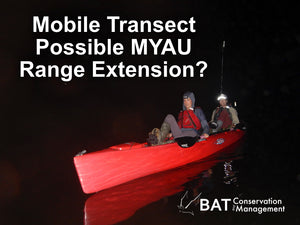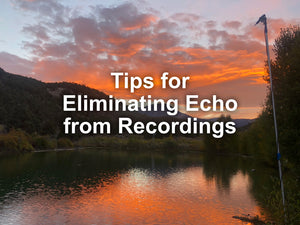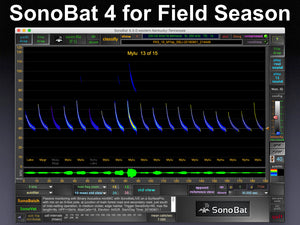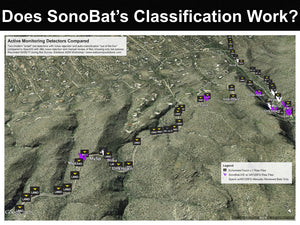Ten Minute Bat Acoustic Monitoring Overview

So, you want to use bat detectors to record bats, eh?
The world of Acoustic Monitoring for bats is challenging indeed and there's a steep learning curve to get up to speed on the equipment and its best use(s) before collecting, post-processing and analyzing the data. One of the best investments of your time early on is to get exposure with the types of equipment, deployment options, and data recording/interpretation. But, to provide you with a little introduction, read on for some basics to whet your appetite, before you decide to delve any deeper.
How do bats use sound to navigate anyway?
The audio component of bat echolocation calls is a wave-form, just like all sound. But unlike many ambient sounds or sounds made by other wildlife, bats use discrete pulses of sound containing very pure tones that have time-frequency and time-amplitude components. And these sounds are almost all above typical human range of hearing, in excess of 20kHz. Typical sounds that bats make range from frequency-modulated (FM; sounds that change in frequency over time) to constant-frequency (CF; sounds that remain at a single frequency over time) in nature. As a wave, these sounds oscillate in amplitude between a positive and negative position. The number of oscillations over a unit of time determines the frequency of the call.
Sounds straightforward, right? But those crafty bats will change the frequencies of their calls depending on what they need to know about their environments. For example, bats navigating through open air without obstructions tend toward using lower frequency, more narrow bandwidth, louder, calls, produced at greater intervals. This provides bats with a "wide angle" acoustic "view" of their distant surroundings, allowing them to discern large objects that are farther away. As a bat moves into a more cluttered environment and needs more rapid information about objects that are closer, it will switch to a higher frequency, larger bandwidth, sometimes lower intensity call pulse that is repeated more frequently to provide up-to-the-second information about its immediate surroundings. So, the sounds that any one bat can make in any one situation can be highly variable. Take home message: Identifying bats on the basis of their echolocation call is a probabilistic process and relatively inexact compared to morphological identification or genotyping. For many species, confident classification can only be achieved on a subset of call types within the bat's repertoire. Despite the challenges presented by attempting to record high-frequency bat echolocation, we have made great strides over recent years to learn more about species-specific echolocation call characteristics.
So, how do we eavesdrop on bats if we can't hear them?
There are two main technologies for transforming the ultrasonic bat echolocation calls into digitized signals that bat-workers can view and analyze to describe bat behavior and under the best-case scenarios, bat identification to species.
1. Zero-crossing (also called "divide by" or "frequency division"). Incoming echolocation calls are sampled at discrete points along their oscillations between positive and negative values to obtain a "trend line" in the time-frequency realm, which provides efficient analysis of representative call parameters. The pros of this technique is to provide near instant renderings of the time-frequency portions of bat calls so bats can be observed while sono-graphs of their calls are displayed. This aids in identifying bats to species. When used passively, in long-term monitoring situations, it is also an efficient way to obtain a lot of data without creating a storage or analysis burden. File-sizes for ZC recordings are between 1 and 4KB in size. They can be manually displayed, viewed, and analyzed rapidly. Automated filters are also extremely efficient at parsing key call characteristics from multiple directories of collected calls simultaneously. The major con of this technique is that it is sensitive only to the signal with the maximum intensity, or volume. Therefore, it will select for the loudest bat sounds on the landscape, biasing itself to collecting more high-intensity echolocating bats if they mask "whispering bats" on the landscape. Also, because lower-frequencies travel longer distances in air, louder bats will be picked up at greater distances which may also mask nearby bats using quieter calls.
2. Full-spectrum. The entire soundscape of an incoming echolocation call is preserved, either by "direct recording methods" which instantly digitize the audio, or by "time-expansion" methods which lower the call in frequency and expand it in time for recording and/or playback in quasi-real-time performance (e.g., a 1.7 second sample is played back over 17 seconds allowing for complete rendering of the bat call, including an audio output). The main benefit of full-spectrum recordings is that they contain not only the time-frequency components of the bat call, but also the time-amplitude components, including multiple harmonics when present. Thus the information recorded by full-spectrum processes is far richer and has vastly more content upon which to make a confident identification. The biggest drawback of full-spectrum recordings is their large file-size and the subsequent storage burden and analysis time spent manipulating recordings. File-sizes for full-spectrum recordings can range from 1-5MB in size.
Where can I find this amazing technology?
There are many different bat detector manufacturers, producing various models that will record high-frequency bat echolocation calls. Some of the most popular detectors at the moment in the USA are:
AnaBat - A Zero-crossing detector only, designed to work most compatibly with AnaLook software for analysis. Several models are available, and most can be connected to a netbook or PDA for instant viewing of the bat call as it is coming in so it can be used for active monitoring. On-board CF storage cards allow for passive monitoring. The small file-sizes of the recordings allows for long-term, season-long or year long recording events to a single high-capacity card.
Pettersson - produces heterodyne, Zero-crossing, Time-expansion, and direct-recording models, including models that combine two or more of these technologies. Different models can be used for active or passive monitoring and many are ideally suited for long-term deployment, with on-board CF card slots to store up to 128GB of recordings. Pettersson detectors have many advantages, including the highest-quality microphones and extremely dependable electronics. The D500x model has become the "go to" full-spectrum, solution for long-term monitoring at several wind turbine installations. With an external battery, the unit can record for 4 weeks at a time and in a 2011 project in PA, two units deployed at a wind farm experienced 100% uptime during an 8-month monitoring period.
Binary Acoustic Technology - produces mainly direct-recording detectors employing the full-spectrum recording technology using the same microphone as in the AnaBat. These units can be paired with external storage devices, netbooks, or laptops for indefinite long-term passive monitoring or to provide snapshots of full-spectrum recordings during active recording or driving transect efforts. They offer the largest selection of USB powered microphones of any manufacturers; each model has aparticular speciality such as type field coverage. Detectors are robust, simple to operate, and reliable under typical field conditions.
Wildlife Acoustics - Their entry into bat models included the SM2+ and EM3 which were both discontinued after only a few seasons in the market. The SM2+ was designed for passive monitoring and includes a reduced sample rate option, which allowed for dual microphone deployment so bats can be recorded on one channel while other wildlife is recorded on the other. Multiple slots for SD-HC flash memory cards allow for unattended monitoring for up to one month. External power and storage capacity will extend this period. The EM3 was designed to be used as an active or short-term passive detector. It had a low resolution on-board LCD screen to display real-time views of bat sonographs in addition to storage for a single SD-HC flash memory card allowing for unattended recording. Both detectors can record zero-cross and full-spectrum data. These devices have been rapidly superceeded by the SM3, SM4 and the Echometer Touch.
Great, so what do I actually have to do with all these recordings to figure out what kind of bats I've got?
There are also many different software products designed for the display and analysis of bat echolocation recordings. The two most popular packages are:
AnaLook W. This software is most compatible with AnaBat detectors, but also allows analysis of files recorded by SM2BAT+ recording in native zero-cross mode. Any full spectrum file can be converted to ZC format and viewed in Analook, however, as mentioned above, sound features such as harmonics and peak frequency are lost. Analook provides a full range of parameter extraction and filtering capabilities for making species identification classifications. The interface is not terribly user friendly however, and true competency can best be obtained thru constant practice and use or by attending a software training workshop.
SonoBat. This program is compatible with any full-spectrum detector unit being produced today. Various utilities are designed to speed post-processing along so calls can be easily and efficiently imported allowing for rapid analysis. The program has a built-in classifier, which will automatically provide call and sequence classifications, outputting a discriminate probability value for the classification as well as a complete set of time-frequency and time-amplitude call parameters for each recording. The interface is very user friendly and versions for Mac OSX and PC Microsoft Windows platforms are available.
Other software products in use include: SCAN'R (Binary Acoustics Technology), BatSound (Pettersson), Avisoft, and Song Scope (Wildlife Acoustics).
I have to admit, I'm confused. This seems to be clear as mud. Where do I go for more information?
Like I started out saying, one of the best investments of your time early on as you begin to explore the wild world of acoustic monitoring, is to get hands-on exposure with the types of equipment, deployment options, and data recording and interpretation tools. Many of your specific questions about bat detector technologies can be answered by as you can try out different recording technologies, using different detectors, and learn an enormous amount about acoustic monitoring protocols, all and backed up with hands-on experiences in the field. Fortunately, there are many excellent training workshops available, which provide these very services.
Bat Conservation and Management, Inc. (BCM; Carlisle, PA) offers tailored training courses specifically for students interested in full-spectrum acoustic recording and analysis using the SonoBat 3.0x software package. Two courses have been designed, one focusing on “Bat Study Techniques” and one on in-depth “SonoBat Software Training” to fully highlight the power and capabilities of this impressive software program. Both courses are taught by Joe Szewczak (SonoBat software developer), and assisted by power-users of the program and various full-spectrum detectors in the field. They are special-focus courses with the former covering seven days and six nights in the field and the later covering two and a half very intensive days in the classroom. They are designed for people already committed to and familiar with the benefits of full-spectrum recording but who need a little help to get the most out of this robust technology.
BCM has offered various other courses from time to time, an "Advanced Capture Techniques" class which is designed for professionals who already have experience handing and identifying bats and need to either brush up on skills or learn more in-depth techniques for targeted capture efforts (e.g., compliance surveys for T&E species; habitat assessments for development and industry; implementing federal inventory or monitoring protocols, etc.). In this course, students will work individually or in teams to perform comprehensive inventories at a site using mist nets, harp traps, bat detectors, and other techniques, as warranted (i.e., roost surveys, video monitoring, etc.) to survey a site and report on results. At this course we provide a good deal of hands-on work with different monitoring protocols, data-collection and analysis methods, and appropriate active and passive use of bat detectors and acoustic monitoring, including mobile transects.
BCM has also conducted courses customized by clients to address particular needs. Decision Maker Workshops are one example of this, where land managers and policy makers obtain "big picture" views in shorter periods of time, as contrasted with end users need to dive into the weeds with equipment, software, and techniques.
Students at all of these courses are encouraged to bring specific bat inventory and monitoring questions to the class, sample data sets, and their own acoustic equipment if they want hands-on instruction in its best uses and deployment options. But, none of this is required. We will cover a full range of inventory and monitoring examples, provide opportunities to collect data during the course, and allow students to use loaner bat detector equipment to gain familiarity with the different units in order to make more informed future purchases or recommendations to their respective agencies/employers.
Bat Conservation International, Inc. (BCI), out of Austin Texas, has pioneered training workshops to teach bat conservation and management techniques. Since 1992-2012, BCI under Janet Tyburec has taught over 2,000 professionals techniques for studying bats.
The best BCI class for delving deeper into bat detectors was the Acoustic Monitoring Workshop. This course is ideal for people who want to try out the different technologies, detector models, and analysis software before making a purchase. It was taught jointly by Chris Corben (AnaBat Detector/AnaLook Software developer) and Joe Szewczak (SonoBat Software developer). They would spend 6-days and 5-nights introducing the technologies, explaining the different detector applications, and teaching participants how to make recordings in the field then post-process and analyze their data in the classroom. It's a well-rounded, intensive introduction to acoustic monitoring. This program ceased in 2013 and today the same staff teaches updated course material thru Bat Survey Solutions.
Anabat Workshops. Cori Lausen has teamed up with Kim Livengood to offer North American Anabat and Analook courses. Their Techniques Training is a course designed to give a good overall understanding of Anabat use and call analysis. Students will learn to be confident in the use of the Anabat system and will gain a working understanding of acoustics to use the system effectively. Participants will gain theoretical understanding and hands on training with the Anabat detector in a number of field implementations and will learn how to manage Anabat data efficiently. Special attention will be given to developing the skills needed to interpret and identify recorded bat calls. In addition, they offer an Analook Analysis Workshop geared to participants who have a basic working knowledge of Analook and have done some call analysis, but who are now faced with large datasets to analyze. This course teaches advanced Analook and analysis techniques including filters and scans for efficient processing of large datasets. Analook Analysis is a course for someone wanting to process files collected by Anabats or by SM2BAT+ running in native zero-cross mode; it can also be used to analyze full-spectrum calls that have been converted to zero-cross (ZC) format (see above for differences between the data-rich full spectrum format and the ZC format).
Janet Tyburec has taught these and other bat inventory and management courses for over twenty years for BCI, BCM, among others, and the staff she retains to assist with the instruction are amongst the highest quality, dedicated educators you will find.
- John Chenger






